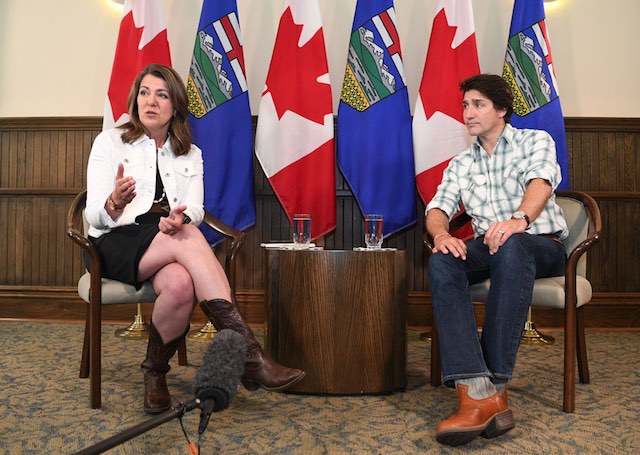Alberta
Premier Smith meets with Prime Minister Trudeau

Premier Danielle Smith met with Prime Minister Justin Trudeau on July 7 to discuss economic priorities.
Although the meeting was constructive, there are still several concerning issues that need to be resolved if Alberta and the federal government are to reach an agreement on an emissions-reduction plan that will simultaneously secure a reliable and affordable electricity grid, protect Alberta workers and drive economic growth in our energy sector for decades.
The positive news is the federal government has agreed to immediately form a bilateral working group with the Alberta government to work on an aligned framework to incentivize investment in carbon capture, utilization and storage as well as other emissions-reducing technologies.
This group would also work to develop a regulatory framework for the construction and use of small modular reactor technology in our province and to secure credit for carbon reduction through increased LNG exports to international markets. Article 6 in the Paris Accord allows for jurisdictions to receive credit for reducing emissions in other countries.
These are welcome developments.
However, the federal government has yet to formally recognize Alberta’s exclusive jurisdiction to set its own emissions-reduction targets and milestones on the path to a carbon-neutral energy sector and electricity grid by 2050.
They continue to set targets for a 42 per cent reduction in energy sector emissions by 2030 and a net-zero electricity grid by 2035. Both of these targets are unachievable, will drive billions of investment out of Alberta, massively increase electricity costs and result in the loss of tens of thousands of Alberta jobs.
We also understand the federal government is set to release its draft so-called ‘clean electricity’ regulations (CER) for feedback in the coming weeks, and which do not initially include a carve-out for provinces like Alberta, which needs more time to transition to a carbon-neutral power grid due to our reliance on natural gas-fired electricity generation.
It will be critical after this initial feedback period is complete that Ottawa grant Alberta’s requested CER carve-out until the working group has reached an agreement on decarbonizing our power grid that Albertans can afford and support.
Albertans have borne the significant cost of replacing all coal-fired electricity generation with natural gas seven years ahead of schedule, for which ratepayers have already paid billions in compensation and will continue to make these compensation payments through 2030.
Alberta has sovereign and exclusive constitutional jurisdiction to regulate our energy and electricity industries. This is non-negotiable.
We have asked the federal government to come to the table in good faith and to assess the realities of our power grid and the true magnitude of being the fifth-largest producer of oil and gas in the world.
If Ottawa does not recognize and support Alberta’s exclusive right to regulate these sectors of our economy, our province will have no choice but to use alternative policy options to protect our rights independent of federal interference.
Our sincere hope is that the newly formed federal and provincial working group will be able to facilitate an agreement that will align Ottawa’s efforts with the Alberta government’s Emissions Reduction and Energy Development Plan.
Failing to reach an agreement on these matters would be an unprecedented missed opportunity that would cost our country tens of billions in economic investment and countless jobs from coast to coast. We look forward to starting the working group as soon as possible.
Alberta
CPP another example of Albertans’ outsized contribution to Canada

From the Fraser Institute
By Tegan Hill
Amid the economic uncertainty fuelled by Trump’s trade war, its perhaps more important than ever to understand Alberta’s crucial role in the federation and its outsized contribution to programs such as the Canada Pension Plan (CPP).
From 1981 to 2022, Albertan’s net contribution to the CPP—meaning the amount Albertans paid into the program over and above what retirees in Alberta received in CPP payments—was $53.6 billion. In 2022 (the latest year of available data), Albertans’ net contribution to the CPP was $3.0 billion.
During that same period (1981 to 2022), British Columbia was the only other province where residents paid more into the CPP than retirees received in benefits—and Alberta’s contribution was six times greater than B.C.’s contribution. Put differently, residents in seven out of the nine provinces that participate in the CPP (Quebec has its own plan) receive more back in benefits than they contribute to the program.
Albertans pay an outsized contribution to federal and national programs, including the CPP because of the province’s relatively high rates of employment, higher average incomes and younger population (i.e. more workers pay into the CPP and less retirees take from it).
Put simply, Albertan workers have been helping fund the retirement of Canadians from coast to coast for decades, and without Alberta, the CPP would look much different.
How different?
If Alberta withdrew from the CPP and established its own standalone provincial pension plan, Alberta workers would receive the same retirement benefits but at a lower cost (i.e. lower CPP contribution rate deducted from our paycheques) than other Canadians, while the contribution rate—essentially the CPP tax rate—to fund the program would likely need to increase for the rest of the country to maintain the same benefits.
And given current demographic projections, immigration patterns and Alberta’s long history of leading the provinces in economic growth, Albertan workers will likely continue to pay more into the CPP than Albertan retirees get back from it.
Therefore, considering Alberta’s crucial role in national programs, the next federal government—whoever that may be—should undo and prevent policies that negatively impact the province and Albertans ability to contribute to Canada. Think of Bill C-69 (which imposes complex, uncertain and onerous review requirements on major energy projects), Bill C-48 (which bans large oil tankers off B.C.’s northern coast and limits access to Asian markets), an arbitrary cap on oil and gas emissions, numerous other “net-zero” targets, and so on.
Canada faces serious economic challenges, including a trade war with the United States. In times like this, it’s important to remember Alberta’s crucial role in the federation and the outsized contributions of Alberta workers to the wellbeing of Canadians across the country.
Alberta
Made in Alberta! Province makes it easier to support local products with Buy Local program

Show your Alberta side. Buy Local. |
When the going gets tough, Albertans stick together. That’s why Alberta’s government is launching a new campaign to benefit hard-working Albertans.
Global uncertainty is threatening the livelihoods of hard-working Alberta farmers, ranchers, processors and their families. The ‘Buy Local’ campaign, recently launched by Alberta’s government, encourages consumers to eat, drink and buy local to show our unified support for the province’s agriculture and food industry.
The government’s ‘Buy Local’ campaign encourages consumers to buy products from Alberta’s hard-working farmers, ranchers and food processors that produce safe, nutritious food for Albertans, Canadians and the world.
“It’s time to let these hard-working Albertans know we have their back. Now, more than ever, we need to shop local and buy made-in-Alberta products. The next time you are grocery shopping or go out for dinner or a drink with your friends or family, support local to demonstrate your Alberta pride. We are pleased tariffs don’t impact the ag industry right now and will keep advocating for our ag industry.”
Alberta’s government supports consumer choice. We are providing tools to help folks easily identify Alberta- and Canadian-made foods and products. Choosing local products keeps Albertans’ hard-earned dollars in our province. Whether it is farm-fresh vegetables, potatoes, honey, craft beer, frozen food or our world-renowned beef, Alberta has an abundance of fresh foods produced right on our doorstep.
Quick facts
- This summer, Albertans can support local at more than 150 farmers’ markets across the province and meet the folks who make, bake and grow our food.
- In March 2023, the Alberta government launched the ‘Made in Alberta’ voluntary food and beverage labelling program to support local agriculture and food sectors.
- Through direct connections with processors, the program has created the momentum to continue expanding consumer awareness about the ‘Made in Alberta’ label to help shoppers quickly identify foods and beverages produced in our province.
- Made in Alberta product catalogue website
Related information
-

 International2 days ago
International2 days agoPope Francis has died aged 88
-

 International1 day ago
International1 day agoJD Vance was one of the last people to meet Pope Francis
-

 2025 Federal Election21 hours ago
2025 Federal Election21 hours agoOttawa Confirms China interfering with 2025 federal election: Beijing Seeks to Block Joe Tay’s Election
-

 Business2 days ago
Business2 days agoCanada Urgently Needs A Watchdog For Government Waste
-

 International1 day ago
International1 day agoPope Francis Dies on Day after Easter
-

 COVID-1921 hours ago
COVID-1921 hours agoNearly Half of “COVID-19 Deaths” Were Not Due to COVID-19 – Scientific Reports Journal
-

 2025 Federal Election21 hours ago
2025 Federal Election21 hours agoHow Canada’s Mainstream Media Lost the Public Trust
-

 2025 Federal Election11 hours ago
2025 Federal Election11 hours agoCHINESE ELECTION THREAT WARNING: Conservative Candidate Joe Tay Paused Public Campaign






